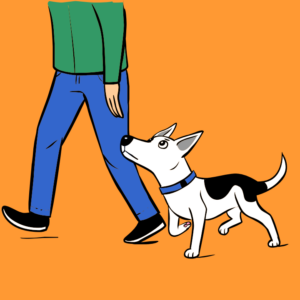 Dogs with noise anxiety become distressed and fearful when they hear certain sounds, such as thunder, fireworks, sirens or traffic. Even the sound of the vacuum cleaner or washing machine can cause a dog to shake, bark or run and hide.
Dogs with noise anxiety become distressed and fearful when they hear certain sounds, such as thunder, fireworks, sirens or traffic. Even the sound of the vacuum cleaner or washing machine can cause a dog to shake, bark or run and hide.
If your dog has noise anxiety, you’re not alone: An estimated 50% of dogs show signs of fear when they hear certain sounds. Noise anxiety can lead to other anxieties: Dogs with this condition are almost three times more likely to also suffer from separation anxiety.
Symptoms of Noise Anxiety in Dogs
When triggered by a specific sound, a dog with noise anxiety may display one or more of these behaviors:
- Trembling
- Ears pinned back
- Look of panic in their eyes
- Whining or barking
- Pacing
- Panting, yawning or drooling
- Constant lip-licking
- Chewing or licking themselves
- Clinginess
- Hiding
- Destructive chewing, digging and scratching
- Trying to escape their environment
- Urinating or defecating
- Vomiting
Dogs can develop noise anxiety at any time and at any age — although it’s more common in dogs over a year old. Here are some of the factors that can lead to this problem:
- Negative association: A previous bad experience when hearing a certain noise can trigger anxiety the next time they’re exposed to the noise.
- Lack of socialization/exposure: A dog that hears a sudden, unfamiliar noise can develop a fear of it.
- Medical condition: A dog that’s ill or in pain is more likely to feel vulnerable and anxious.
- Age: It’s not uncommon for dogs to become more anxious as they get older due to changes in their brain chemistry and general health.
Treatment Options for Noise Aversion
Your dog’s noise anxiety won’t go away by itself and could get worse if it’s not treated. To explore your options and create a plan of action, make an appointment with your veterinarian, or a veterinary behaviorist, certified behavior consultant or certified dog trainer.
Medication
In more severe cases of noise anxiety, medication can be helpful — especially when used in combination with other training techniques and therapies. Talk with your veterinarian or a veterinary behaviorist.
Note: Never give your dog human medication without first consulting your veterinarian.
Counter Conditioning and Desensitization
When used together, these behavior modification techniques are highly effective in reducing and treating noise anxiety:
- Counter conditioning teaches your dog that good things happen (e.g., treats, toys, etc.) whenever they’re exposed to the noise. Over time, they stop panicking whenever they hear the noise because they’ve learned to associate it with something positive.
- Desensitization helps your dog get used to hearing the noise. This technique involves playing the sound at a very low volume and then slowly and carefully increasing the volume over time.
For the best results, we recommend working with a certified behavior consultant or dog trainer. An experienced professional can provide you with effective and positive training techniques, and help you identify your dog’s threshold — how loud the sound can be before your dog starts to exhibit signs of anxiety. It’s extremely important to progress at your pet’s speed.
Other Therapies
In addition to medication and behavior modification techniques, you can also explore:
- Anti-anxiety wearables, such as a compression jacket or hood
- Calming supplements
- Pheromones
- Massage
- Acupuncture
- White noise or calming music (which can also help muffle noises that might be frightening your dog)
Note: You should never scold or “discipline” your dog for their behavior. This will only create more stress and fear.
